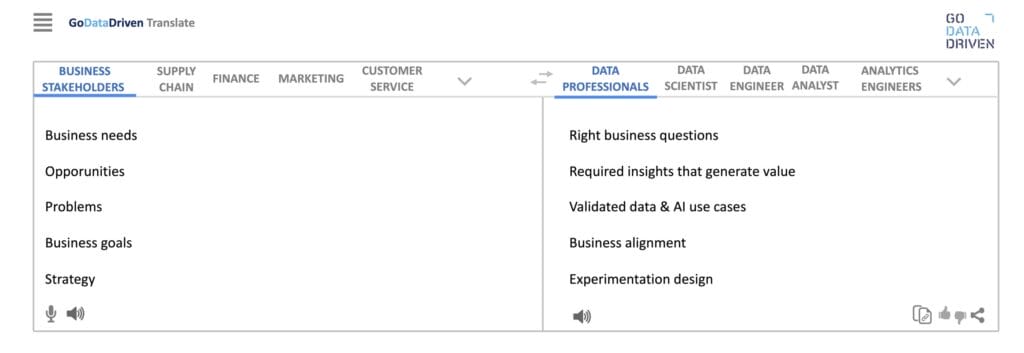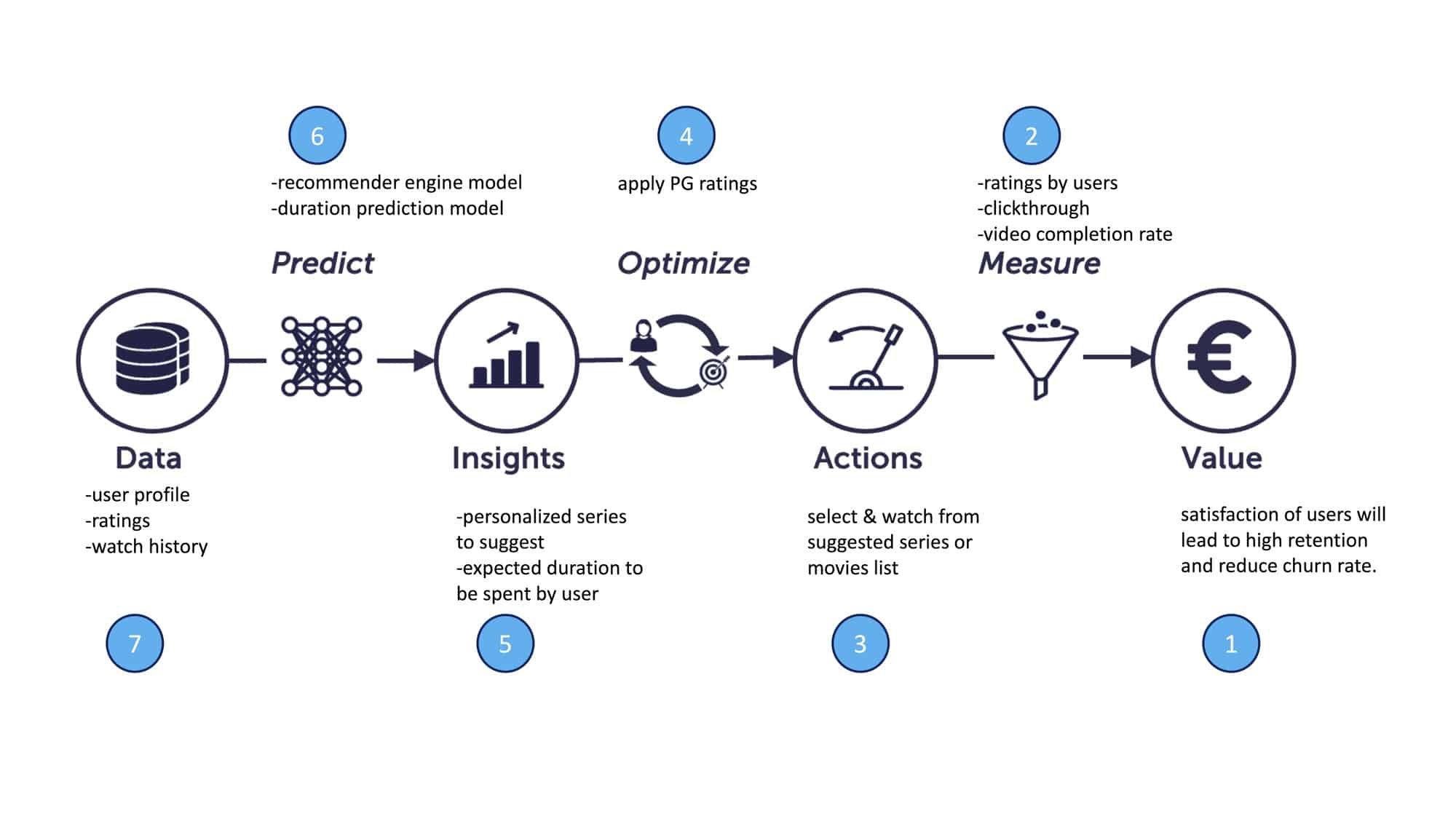85 percent of Data Science projects fail to deliver according to Gartner. Failures of these projects have different reasons. Two of the main reasons are the poor business alignment and not focusing on the right business questions and needs. In 2018, Mckinsey introduced Analytics Translator as the new must-have role in any organization and estimated that the demand for this role, in USA only, may reach 2 to 4 million.
An Analytics Translator helps in bridging the needs of business stakeholders and operational teams (e.g., marketing and supply chain) with the technical expertise of data teams such as data scientists, data engineers, and analytics engineers. The analytics translator makes sure that data & AI projects will lead to impact on scale to the organization.
In this blog, we consider Google Translate as an analogy to discuss the Why and How aspects of the analytics translator role. This blog is very relevant for you if:
- you just started your career as an analytics translator and want to learn more about the role,
- you work as a product owner on AI or data projects and want to ensure that these products will add value for the organization,
- you currently have a technical role (e.g., data analyst, data scientist, or data engineer) and want to switch to an analytics translator role or you want to learn how to align more with business stakeholders to bring more value to your organization
1. Why do organizations need an Analytics Translator?
When we receive an email in a language that we do not speak or understand, we often think about using an online translator such as Google Translate to translate this email into a language that we are familiar with (e.g., English). In this context, Google Translate is an enabler for two parties to understand each other by translating back and forth between their different languages.
In a business context where organizations want to execute AI and data-driven strategy, there is often a gap between data experts and the business. On one hand, data engineers are good at developing robust applications and data scientists are good at distilling intelligence from data. On the other hand, business teams know their specific processes, needs, and goals. In this context, we would like to have someone who acts as Google Translate (as shown in Figure 1). He or she becomes an enabler and ensures strong alignment between data experts and business. This is where the Analytics Translator role fits in.
Knowing from business what is desired and what is possible, an analytics translator finds the right use cases that are realistic, valuable, feasible, and that are the right fit for the company’s strategy. Consequently, the data experts are well aligned with the needs of the business.

As a liaison between experts and business, analytics translators guarantee that the business understands and adopts the AI solutions. While the data experts focus on the technical implementation, analytics translators make sure that the output is actionable and fits business needs. They know how to communicate a business idea to the experts and embed the result in your organization.
In a nutshell, the analytics translator does the following:
- identifies high impact business problems that can be solved with data science and build strong business cases around them,
- ensures that the data science and engineering team understands the business problem and are able to set out an appropriate analytical and data roadmap, and
- helps to interpret and deliver the outcome, embedding this in both the business and IT landscape of the organization.
2. How do Analytics Translators bring value to the organization?
In order to build a valuable AI solution, you need to get two things right. One, make sure that the business problem you are addressing is the right one. Two, make sure that the solution satisfies
the needs of your end user and is built correctly.
Back to our Google Translate analogy, Google is using billions of examples as an input together with complex Machine & Deep learning algorithms in order to translate between different languages. Similar to Google Translate, the analytics translator needs to have some characteristics (inputs) and uses a specific approach (algorithms) in order to be able to translate business problems into strong data and AI use-cases.
The characteristics of the analytics translator therefore could be summarized as follows:
- having deep domain expertise,
- having an understanding of the different machine learning models and how they can realistically be applied and
- having digital product management skills (entrepreneurship, product design, experimentation, backlog prioritization, and stakeholder management).
Having the above mentioned characteristics, the analytics translator uses design thinking, lean startup, agile skills, and a value-driven approach to make sure that the AI solutions are aligned with the business needs and that they create an impact for the organization. While following this approach, the analytics translator is aligning with technical, business, and operational stakeholders. This approach could be summarized as follows:
- the analytics translator starts with the business value and translates it into relevant and feasible AI initiatives,
- the analytics translator defines some measurements or KPIs that will be used to assess if the business value is reached or not,
- the analytics translators defines which actions need to be taken by end-users or stakeholders to achieve the business value,
- the analytics translator defines which insights are required that would enable end-users to perform the required actions,
- the analytics translator works with the technical team to build a proof of concept to generate the required insights,
- the analytics translator works on a proof of value using the pre-defined measurements and KPIs,
- the analytics translator checks the success of the proof of concept (feasibility) and the proof of value (desirability & viability),
- the analytics translator helps the organization to industrialize the AI solutions and to create an impact on scale.
Figure 2 shows how analytics translator could apply the above mentioned approach by following the data science value chain. In this example, Netflix wants to increase user retention on their platform. The analytics translator starts with the end value in mind while building and validating a "personalized recommendations" AI use case. By following steps 1 to 7, the analytics translator defines what is required to make a proof of concept and also the proof of value for this specific AI use-case. Accordingly, the analytics translator is making sure that the AI use case is aligned with the business needs and will lead to an impact.

Conclusion
In this article, we discussed the Analytics Translator role and how it bridges the gap between technical experts and business stakeholders. We used Google Translate as an analogy to this role. Similar to Google Translate, the analytics translator needs to be empowered with a strong input (knowledge base) in order to be able to translate the business problems into valuable AI solutions that achieve the business goals for an the organization. Moreover, like Google Translate is using strong and complex machine and deep learning algorithms to perform translations between different languages, the analytics translator is following a value-driven approach (e.g., using the data science value chain). This approach makes sure that any AI solution will generate an impact for the organization.
For more information about the role of analytics translator, please check out https://xebia.com/blog/category/topics/analytics-translation/




